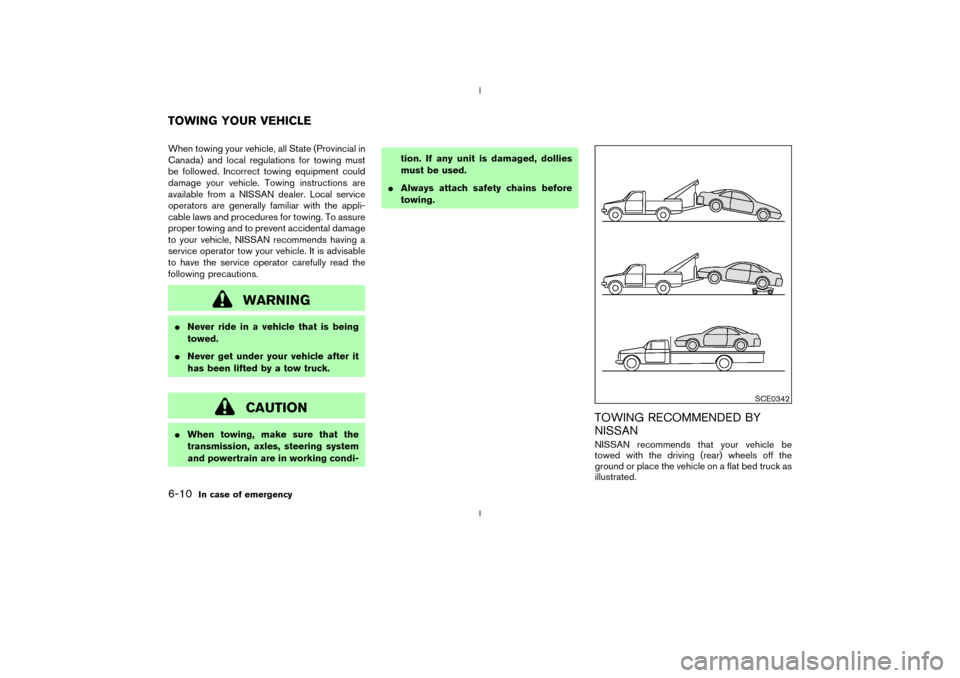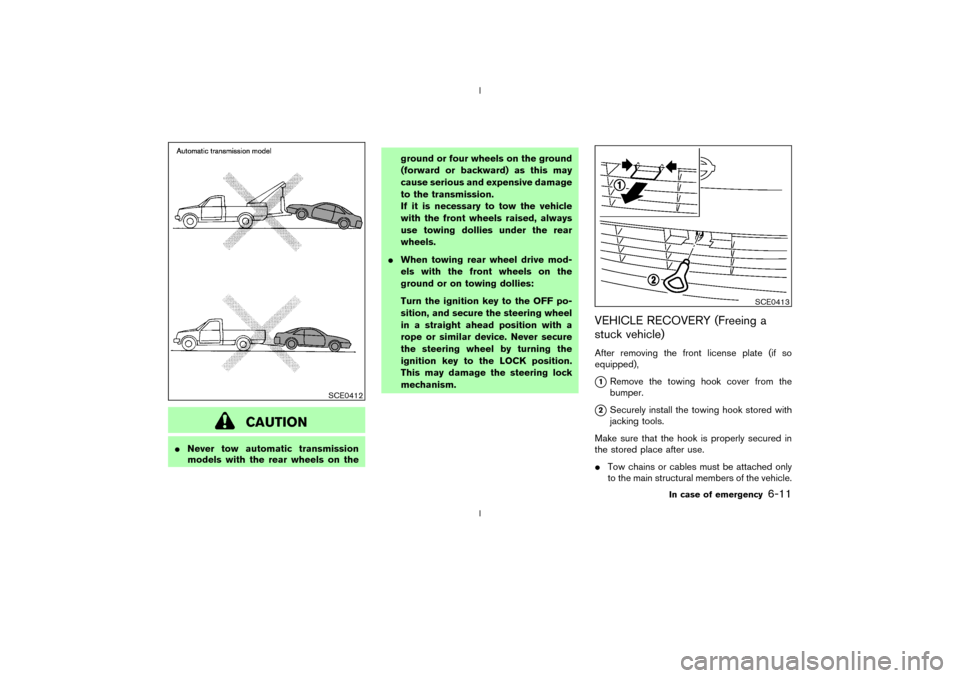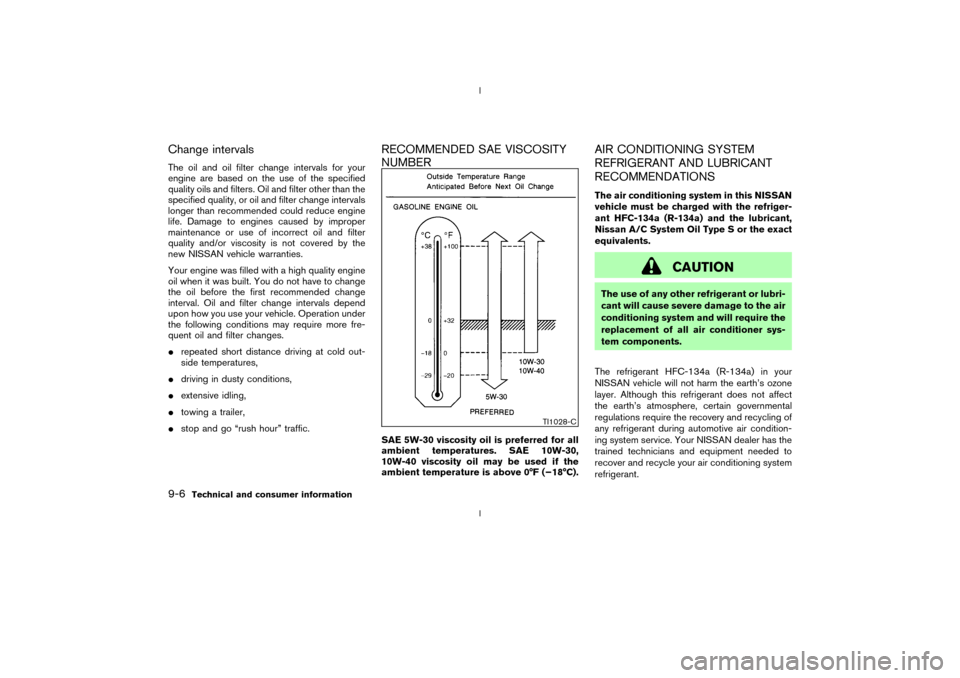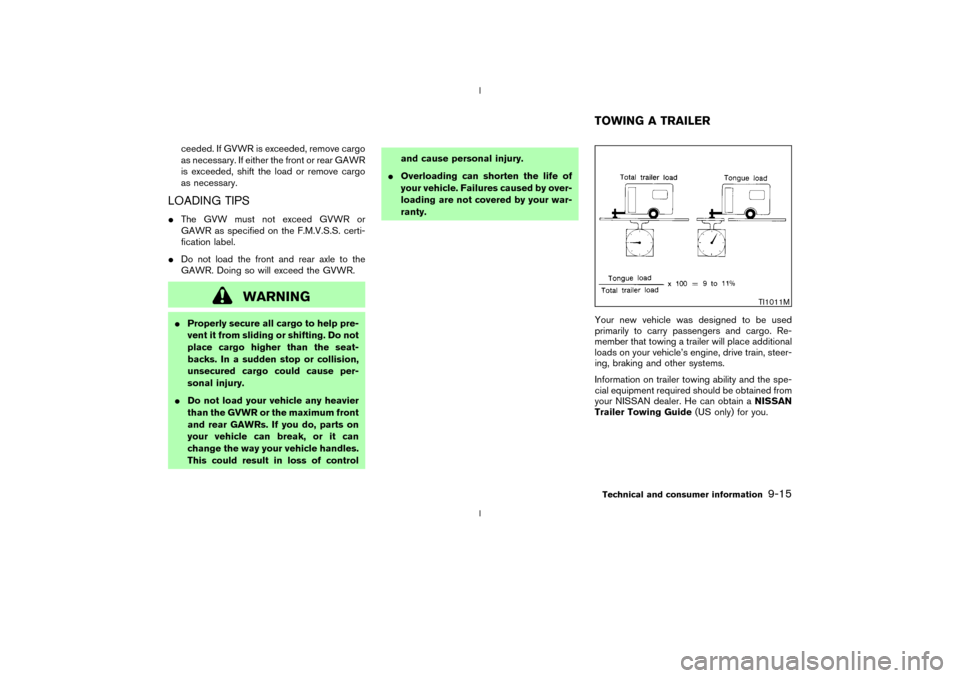2003 NISSAN 350Z towing
[x] Cancel search: towingPage 144 of 227

6 In case of emergencyFlat tire ...................................................................................... 6-2
Low tire pressure warning system
(if so equipped) ................................................................ 6-2
Changing a flat tire .......................................................... 6-2
Jump starting ........................................................................... 6-6Push starting ........................................................................... 6-8
If your vehicle overheats....................................................... 6-9
Towing your vehicle ............................................................ 6-10
Towing recommended by NISSAN........................... 6-10
Vehicle recovery (Freeing a stuck vehicle) ............. 6-11
Z
02.9.13/Z33-D/V5.0
X
Page 149 of 227

For models equipped with the low tire
pressure warning system:
After adjusting tire pressure to the COLD tire
pressure, the display of the tire pressure infor-
mation may show higher pressure than the
COLD tire pressure after the vehicle has been
driven more than 1 mile (1.6 km). This is because
the tire pressurizes as the tire temperature rises.
This does not indicate a system malfunction.
WARNING
Retighten the wheel nuts when the ve-
hicle has been driven for 600 miles
(1,000 km) (also in cases of a flat tire,
etc.).Stowing the tire and toolsSecurely store the spare tire and jacking equip-
ment in the vehicle.
WARNING
IAlways make sure that the spare tire
and jacking equipment are properly
secured after use. Such items canbecome dangerous projectiles in an
accident or sudden stop.
IThe T-type spare tire and small size
spare tire are designed for emer-
gency use. See ªWheels and tiresº in
the ª8. Maintenance and do-it-
yourselfº section.To start your engine with a booster battery, the
instructions and precautions below must be
followed.
WARNING
IIf done incorrectly, jump starting can
lead to a battery explosion, resulting
in severe injury or death. It could also
damage your vehicle.
IExplosive hydrogen gas is always
present in the vicinity of the battery.
Keep all sparks and flames away
from the battery.
IDo not allow battery fluid to come
into contact with eyes, skin, cloth or
painted surfaces. Battery fluid is a
corrosive sulphuric acid solution
which can cause severe burns. If the
fluid should come into contact with
anything, immediately flush the con-
tacted area with water.
IKeep battery out of the reach of chil-
dren.
IThe booster battery must be rated atJUMP STARTING
6-6
In case of emergency
Z
02.9.13/Z33-D/V5.0
X
Page 153 of 227

When towing your vehicle, all State (Provincial in
Canada) and local regulations for towing must
be followed. Incorrect towing equipment could
damage your vehicle. Towing instructions are
available from a NISSAN dealer. Local service
operators are generally familiar with the appli-
cable laws and procedures for towing. To assure
proper towing and to prevent accidental damage
to your vehicle, NISSAN recommends having a
service operator tow your vehicle. It is advisable
to have the service operator carefully read the
following precautions.
WARNING
INever ride in a vehicle that is being
towed.
INever get under your vehicle after it
has been lifted by a tow truck.
CAUTION
IWhen towing, make sure that the
transmission, axles, steering system
and powertrain are in working condi-tion. If any unit is damaged, dollies
must be used.
IAlways attach safety chains before
towing.
TOWING RECOMMENDED BY
NISSANNISSAN recommends that your vehicle be
towed with the driving (rear) wheels off the
ground or place the vehicle on a flat bed truck as
illustrated.
SCE0342
TOWING YOUR VEHICLE6-10
In case of emergency
Z
02.9.13/Z33-D/V5.0
X
Page 154 of 227

CAUTION
INever tow automatic transmission
models with the rear wheels on theground or four wheels on the ground
(forward or backward) as this may
cause serious and expensive damage
to the transmission.
If it is necessary to tow the vehicle
with the front wheels raised, always
use towing dollies under the rear
wheels.
IWhen towing rear wheel drive mod-
els with the front wheels on the
ground or on towing dollies:
Turn the ignition key to the OFF po-
sition, and secure the steering wheel
in a straight ahead position with a
rope or similar device. Never secure
the steering wheel by turning the
ignition key to the LOCK position.
This may damage the steering lock
mechanism.
VEHICLE RECOVERY (Freeing a
stuck vehicle)After removing the front license plate (if so
equipped),q1Remove the towing hook cover from the
bumper.
q2Securely install the towing hook stored with
jacking tools.
Make sure that the hook is properly secured in
the stored place after use.
ITow chains or cables must be attached only
to the main structural members of the vehicle.
SCE0412
SCE0413
In case of emergency
6-11
Z
02.9.13/Z33-D/V5.0
X
Page 155 of 227

IPulling devices should be routed so they do
not touch any part of the suspension, steer-
ing, brake or cooling systems.
IAlways pull the cable straight out from the
front of the vehicle. Never pull on the vehicle
at an angle.
IPulling devices such as ropes or canvas
straps are not recommended for use in ve-
hicle towing or recovery.
IStand clear of a stuck vehicle.
WARNING
Do not spin your tires at high speed.
This could cause them to explode and
result in serious injury. Parts of your
vehicle could also overheat and be dam-
aged.6-12
In case of emergency
Z
02.9.13/Z33-D/V5.0
X
Page 196 of 227

9 Technical and consumer informationCapacities and recommended fuel/lubricants ................ 9-2
Fuel recommendation...................................................... 9-3
Engine oil and oil filter recommendation.................... 9-5
Recommended SAE viscosity number ....................... 9-6
Air conditioning system refrigerant and lubricant
recommendations ............................................................. 9-6
Specifications.......................................................................... 9-8
Engine ................................................................................. 9-8
Wheels and tires .............................................................. 9-9
Dimensions and weights ................................................ 9-9
When traveling or registering your vehicle in another
country.................................................................................... 9-10
Vehicle identification ........................................................... 9-10
Vehicle identification number (VIN) plate ................ 9-10
Vehicle identification number (Chassis number) ... 9-10
Engine serial number .................................................... 9-11
F.M.V.S.S. certification label ....................................... 9-11
Emission control information label ............................ 9-11Tire placard ..................................................................... 9-12
Air conditioner specification label ............................. 9-12
Installing front license plate .............................................. 9-13
Vehicle loading information ............................................... 9-14
Terms ................................................................................ 9-14
Determining vehicle load capacity ............................ 9-14
Loading tips .................................................................... 9-15
Towing a trailer .................................................................... 9-15
Maximum load limits ...................................................... 9-16
Towing safety.................................................................. 9-17
Uniform tire quality grading............................................... 9-19
Emission control system warranty ................................... 9-20
Reporting safety defects (US only) ................................ 9-20
Readiness for inspection/maintenance (I/M) test
(US only)................................................................................ 9-21
Owner's manual/service manual order information ... 9-22
In the event of a collision ............................................ 9-22
Z
02.9.13/Z33-D/V5.0
X
Page 201 of 227

Change intervalsThe oil and oil filter change intervals for your
engine are based on the use of the specified
quality oils and filters. Oil and filter other than the
specified quality, or oil and filter change intervals
longer than recommended could reduce engine
life. Damage to engines caused by improper
maintenance or use of incorrect oil and filter
quality and/or viscosity is not covered by the
new NISSAN vehicle warranties.
Your engine was filled with a high quality engine
oil when it was built. You do not have to change
the oil before the first recommended change
interval. Oil and filter change intervals depend
upon how you use your vehicle. Operation under
the following conditions may require more fre-
quent oil and filter changes.
Irepeated short distance driving at cold out-
side temperatures,
Idriving in dusty conditions,
Iextensive idling,
Itowing a trailer,
Istop and go ªrush hourº traffic.
RECOMMENDED SAE VISCOSITY
NUMBERSAE 5W-30 viscosity oil is preferred for all
ambient temperatures. SAE 10W-30,
10W-40 viscosity oil may be used if the
ambient temperature is above 0ÉF (þ18ÉC).
AIR CONDITIONING SYSTEM
REFRIGERANT AND LUBRICANT
RECOMMENDATIONSThe air conditioning system in this NISSAN
vehicle must be charged with the refriger-
ant HFC-134a (R-134a) and the lubricant,
Nissan A/C System Oil Type S or the exact
equivalents.
CAUTION
The use of any other refrigerant or lubri-
cant will cause severe damage to the air
conditioning system and will require the
replacement of all air conditioner sys-
tem components.
The refrigerant HFC-134a (R-134a) in your
NISSAN vehicle will not harm the earth's ozone
layer. Although this refrigerant does not affect
the earth's atmosphere, certain governmental
regulations require the recovery and recycling of
any refrigerant during automotive air condition-
ing system service. Your NISSAN dealer has the
trained technicians and equipment needed to
recover and recycle your air conditioning system
refrigerant.
TI1028-C
9-6
Technical and consumer information
Z
02.9.13/Z33-D/V5.0
X
Page 210 of 227

ceeded. If GVWR is exceeded, remove cargo
as necessary. If either the front or rear GAWR
is exceeded, shift the load or remove cargo
as necessary.
LOADING TIPSIThe GVW must not exceed GVWR or
GAWR as specified on the F.M.V.S.S. certi-
fication label.
IDo not load the front and rear axle to the
GAWR. Doing so will exceed the GVWR.
WARNING
IProperly secure all cargo to help pre-
vent it from sliding or shifting. Do not
place cargo higher than the seat-
backs. In a sudden stop or collision,
unsecured cargo could cause per-
sonal injury.
IDo not load your vehicle any heavier
than the GVWR or the maximum front
and rear GAWRs. If you do, parts on
your vehicle can break, or it can
change the way your vehicle handles.
This could result in loss of controland cause personal injury.
IOverloading can shorten the life of
your vehicle. Failures caused by over-
loading are not covered by your war-
ranty.
Your new vehicle was designed to be used
primarily to carry passengers and cargo. Re-
member that towing a trailer will place additional
loads on your vehicle's engine, drive train, steer-
ing, braking and other systems.
Information on trailer towing ability and the spe-
cial equipment required should be obtained from
your NISSAN dealer. He can obtain aNISSAN
Trailer Towing Guide(US only) for you.
TI1011M
TOWING A TRAILERTechnical and consumer information
9-15
Z
02.9.13/Z33-D/V5.0
X